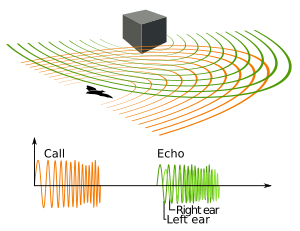Animal echolocation facts for kids
Echolocation, also known as bio sonar, is a special way some animals use sound to "see" their surroundings. It's like a natural sonar system. Animals that echolocate make sounds and then listen for the echoes that bounce back from objects. These echoes help them figure out where things are and what they are.
Animals use echolocation for many reasons. They use it to find their way around, especially in the dark or in murky water. They also use it to hunt for food.
Many different animals use echolocation. The most famous ones are bats (especially microbats) and toothed whales and dolphins. But other animals also use it. These include shrews, a type of fruit bat called Rousettus, and two kinds of cave-dwelling birds: swiftlets and the Oilbird.
Contents
How Does Echolocation Work?
Echolocation is very similar to how human-made sonar works. The animal sends out a sound. Then, it listens carefully for the sound to bounce back. This bounced-back sound is called an echo.
Measuring Distance and Direction
Animals figure out how far away an object is by measuring the time it takes for the echo to return. If the echo comes back quickly, the object is close. If it takes longer, the object is farther away.
They also use their two ears to figure out direction. The echo might arrive at one ear slightly before the other. It might also sound louder in one ear than the other. These tiny differences help the animal know exactly where the object is located.
What Animals Can "See"
With echolocation, an animal can do more than just find objects. A bat, for example, can tell how big another animal is. It can also figure out what kind of animal it is. This amazing sense helps them navigate and hunt in their environment.
The Brain's Role
The animal's brain is key to echolocation. Special parts of the brain quickly calculate the tiny differences in sound. This allows the animal to build a detailed picture of its surroundings using only sound.
Images for kids
See also
 In Spanish: Ecolocalización para niños
In Spanish: Ecolocalización para niños



